Will Pfeifer's Blog, page 2
October 6, 2019
Movies I Watched: Joker
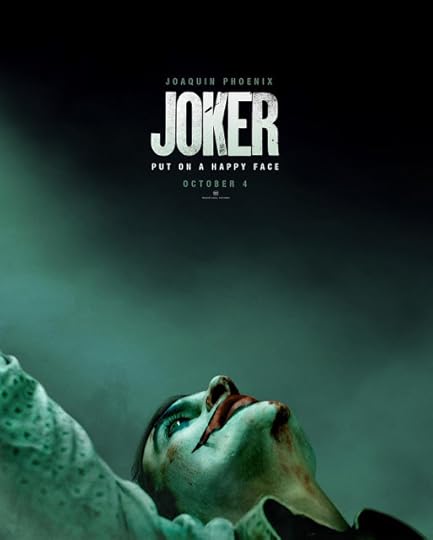
Or, as the actual title reads, JOKER, in giant caps that blast onto the screen early and suddenly, in a way that feels suspiciously reminiscent of other (dare I say) better productions, like CABIN IN THE WOODS and MINDHUNTER.
I saw JOKER opening weekend at a 10:45 show. The crowd was sparse, to put it kindly, with only a dozen or so people in the audience, and there were no incidents, violent or otherwise. The only sign of any sort of controversy or unease was the sullen employee of "Global Security" who asked us to leave the lobby after the show, but whether he wanted to avoid any JOKER-fueled trouble or just wanted to go home, I don't know. (In his defense, it was after 1 a.m.).
So, anyway, I have a few thoughts about the movie itself. I'm going to spoil a lot, including the ending, so read at your own risk:
1. Right off the bat, I didn't like it. I wanted to, believe me. As someone who's a lifelong fan of both comic books and serious, challenging movies, I thought the trailer looked promising, hinting at the sort of movie that could take comic book-inspired entertainment in a different direction than the (admittedly very entertaining) Marvel model. And it does go in a different direction. Just not a good one.
2. The JOKER's biggest problem, I'd argue, is that it takes itself much too seriously -- more seriously than either of the movies it obviously, desperately tries to be, "Taxi Driver" and "The King of Comedy." From the opening frames, JOKER is so intent on piling misery after misery on poor Arthur Fleck that it becomes funny, and not in the way the filmmakers intend. Even (especially) the darkest films have their lighter moments, either to relieve the tedium of unrelenting bleakness or to make things seem even darker by contrasting them with a few bright spots. But JOKER can't figure out a way to make Fleck's descent into madness convincing other than heap tragedy on top of his disturbingly frail form. By the time we see Fleck entertaining kids in a cancer ward, I half expected them all to be massacred onscreen. (That doesn't happen, but that scene doesn't end well for Fleck, trust me.)
3. Which brings us to Fleck, and to Joaquin Phoenix, and to his performance. It's a startling, impressive bit of acting, which is what I expect from Phoenix, one of the best (and most challenging) actors working today. My question is, is it the right performance for THIS movie and THIS character? Fleck, like I've said, is a man beaten down daily by life, and though Phoenix believably conveys his shattered spirit, his constant gyrating and dancing around feels more like an actorly affectation than anything poor Fleck would actually do. In "Taxi Driver," another movie about a man losing his sanity in a dying city, Robert De Niro (more on him in a bit) makes Travis feel lived in, a man of contradictions and, more importantly, a man fighting against his mental decline. Phoenix, as dedicated as he is (and boy oh boy, is this a dedicated performance), feels like a guy leaning into it.
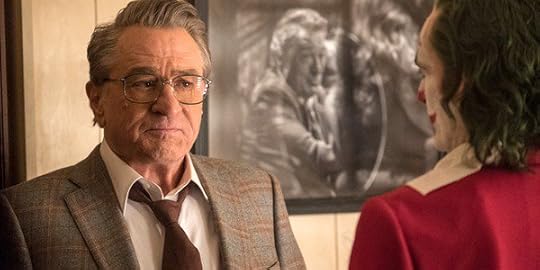
4. Speaking of Mr. De Niro, in JOKER he plays a late-night talk show host in what's obviously a nod to JOKER's other big inspiration, Scorsese's "The King of Comedy." In that movie, De Niro plays Rupert Pupkin, an unhinged nebbish who fantasizes about becoming a comedy star on a hit talk show. In other words, he's Arthur Fleck 40 years earlier and several degrees more complex. In this movie, De Niro plays the talk show host, but there's a problem: While De Niro is undeniably one of the all-time great actors, he's not the least bit convincing as a talk show host. It's a surprisingly tough role to nail, and De Niro's natural edginess doesn't work here. It feels, if anything, like a "Saturday Night Live" sketch, and not a good one. There's a reason Scorsese cast Jerry Lewis as Jerry Langford in "The King of Comedy." In addition to his movie work, Lewis had extensive experience hosting talk shows, both his own and the legendary "Tonight Show." It paid off beautifully in that movie, and casting someone else would have paid off here, too -- though, without De Niro, Phillips and company wouldn't get their all-important connection to those other (better) movies.
5. Like Pupkin did in "The King of Comedy," Fleck has delusions throughout joke. Right off the bat, he fantasizes that he's on De Niro's show, welcomed warmly by the host and accepted instantly by the audience. (This is similar, but not nearly as effective, as the scenes in "The King of Comedy" where Pupkin fantasizes about being Jerry Langford's buddy. For one thing, Fleck is so endlessly pathetic, we're supposed to feel sorry him at all times and be grateful when fantasy De Niro hugs him like a son. Pupkin, on the other hand, becomes an asshole even in his fame fantasy, which feels both more realistic and more dangerous.) But that's not the only fantasy in JOKER: Fleck also meets a single mom (Zazie Beetz of "Deadpool 2") in his run-down apartment building, and they seem to form a connection, with her attending his stand-up debut and him triumphantly kissing her later in the movie. But it's all in his head, of course, and when we see the real woman near the end, it turns out she (a) doesn't know him and (b) is justifiably terrified to find him in her apartment. That's all fine, and it's one of the few twists -- even if it's pretty obvious -- that works. But director Phillips can't resist making sure the audience doesn't miss the point and pointless inserts scenes showing how Fleck's delusional memories really happened, underlining the revelation -- and spoiling the effect. (Some might argue that other sections of the movie, like the riotous finale, are in Fleck's head, too, but I think that's giving JOKER way too much credit.)
6. Plotwise, JOKER pairs Fleck's descent into madness (or, I guess, more madness) with societal unrest that explodes in riots full of clown mask-clad tough guys gleefully tearing down Gotham's elite. That's fine, and it (thankfully) expands the movie beyond the stifling scope of poor little Arthur Fleck. Trouble is, it's never the least bit convincing. The whole anarchist movement is sparked when Fleck kills three brutally abusive yuppies on a subway. (In what might be the least believable moment in the entire film, one of those yuppies knows all the words to "Send in the Clowns.") Though there are exactly zero witnesses to the murders, by the next day news of the killer clown is all over the papers and, somehow, a KILL THE RICH movement is the talk of the town. Thomas Wayne (yes, Batman's dad) gives an interview where he refers to the poor as "clowns," and bing bang boom, a political revolution is not only started, it's jump-started to become a mass movement. All in what feels like a few hours.
7. Which brings us to the whole Batman angle. I hate to tell Todd Phillips and his co-writer Scott Silver this, but if you want to use an iconic character like the Joker to tell a serious, grown-up story, it's best not to bend over backwards to link it back to the super-hero comics that inspired it. When Thomas Wayne was just a symbol of Gotham's cruel ruling class, the movie felt right, like it knew how to take the right elements from the comics and spin them in interesting directions. But from the moment we glimpse Thomas' young son Bruce in a newspaper photo, it feels like a reach. By the time Fleck talks with lil' Bruce at the gates of Wayne Manor until a guy with a British accent (Alfred, I'm guessing) chases him away, this supposedly adult drama has gone too far into the comic book land. And the ending, which manages to tie Batman's origin into the Joker in a way only slightly less ridiculous than the 1989 "Batman" movie, actually made me laugh out loud in the theater. If I have to see Martha Wayne's string of pearls fall to the pavement one more time...
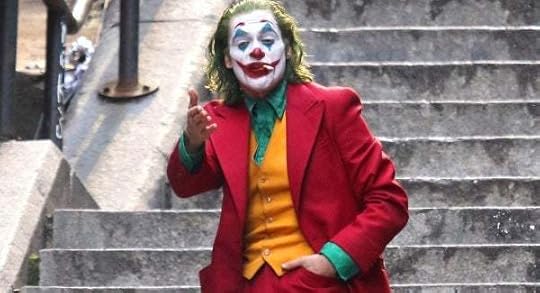
8. And that's why JOKER didn't work for me. It thinks it knows what it wants to be -- a serious, seriously dark examination of personal madness and societal alienation -- but it can't resist trying to be "cool" at every turn. Phoenix, as I said, turns in a hell of a performance (whether it fits the movie or not is up for debate), but Phillips undercuts what he's trying to do by staging it so Fleck is always the one we feel sorry for and, as the movie goes on, root for. Even at the end when (spoilers) he kills his own mother (!), it feels like something the movie agrees with and not like something we're meant to take issue with. He has to do it so he can make his full transformation to the JOKER ... and so, it's implied, the fun can begin. To bring things back to "Taxi Driver" again, Travis is beaten down, and we feel bad for him, but we also realize he's genuinely unhinged, and not in a cool way -- in a genuinely dangerous way. That's why his rampage, as cathartic as it is, leaves us with a distinctly uneasy feeling. By the end of this movie, when Fleck is all dressed and made up as the JOKER, walking to his star-making appearance on De Niro's show, Phillips makes him appear like the epitome of edgy cool, dancing along to Gary Glitter's "Rock and Roll Part 2" (of all things) like he's striding into a wrestling match to his own theme music. Any pretense of seriousness is left far behind at this point, and the far-fetched bloody finale is the icing on the dopey cake.
9. JOKER ends with our hero posed triumphant as an army of clowns (where did they get all those matching masks?) stands around him, Gotham City in flames and poor lil' Bruce in an alley nearby with the bodies of his parents. By the way, Batman's origin, with his mom and dad walking through a dark alley after a movie, has always felt more than a tad unbelievable, but in this movie, with Gotham consumed by riots, feels outlandish. Why would his parents choose this night and this theater (in what's obviously a terrible part of town) to take in a viewing of either "Zorro the Gay Blade" or "Blow Out"?
10. In one of the very last shots, after a pointless "Network" "homage," Phillips has the nerve to put this Joker in the back of a police car, gazing out at the chaos he's caused in a scene that deliberately echoes a famous shot of Heath Ledger in "The Dark Knight." This turns out to be an especially ill-considered move, because it only reminds the audience of a much better Joker ... in a much better movie.
Published on October 06, 2019 10:31
September 16, 2019
Movies I Watched: 'Ladies They Talk About'
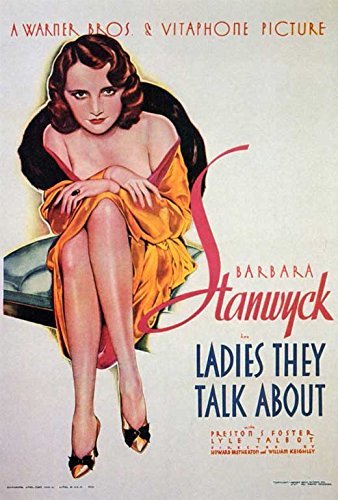
Is this the first-ever women-in-prison movie? There's probably some silent film along those lines that I've never seen, but it's amazing how, way back in 1933, so many of the elements of the genre were already in place. Barbara Stanwyck plays Nan, a smart cookie who provides distraction while a gang of guys robs a bank. The fellas get away, but a cop who knows Nan arrests her and, despite a brief flirtation with a politically connected social reformer (Preston Foster), she winds up in San Quentin. Which, of course, is where the fun begins.
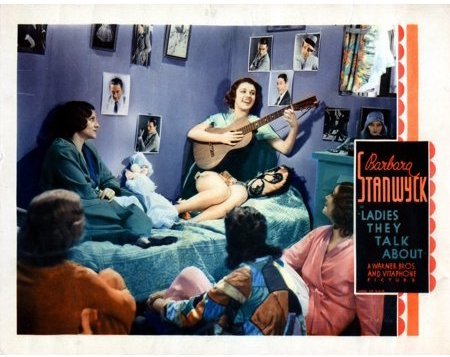
San Quentin turns out to be a pretty swell place, more like the wiseguy's private prison quarters in "Goodfellas" than any sort of actual penitentiary. The women decorate their cells in homey fashion, they're allowed to wander all over the place, and the restroom serves as a combination smoking lounge/rec room. Even the prisoners themselves are a (mostly) relatively pleasant sort, with Lillian Roth (from "Animal Crackers") giving "new fish" Nan the grand tour. Along the way, we meet pre-Code stalwart Ruth Donnelly (with a cockatoo on her shoulder), Madame Sul-Te-Wan (as a refreshingly tough African American prisoner) and Louise Emmons (who I'll always remember as the supremely creepy headmistress in the Our Gang short "Mush and Milk."). There's even a big tough prisoner lesbian (who smokes a stogie) about whom Roth warns "she likes to wrestle." Speaking of Roth, in the movie's most outrageous bit of corporate synergy, she sings a love song to a photo of fellow Warner Bros. star Joe E. Brown.
"Ladies They Talk About" isn't a great movie by any means, and it lacks the sleazy thrills that would come with later women-in-prison flicks. But it's a fine showcase for Stanwyck, my all-time favorite actress. Unlike almost every other actress of her generation, Stanwyck excelled at underplaying. Without the loud outbursts and crying jags that others relied on, Stanwyck was able to be the calm center of the scene, giving every indication that she was, in almost every case, the smartest person in the room. That's definitely the case here, and always a sucker for her sardonic, cynical persona. As a bonus, all that underplaying makes her big emotional scene at the end all the more effective. It's not much of a spoiler to reveal that she winds up with the aforementioned social reformer, but by the time the final scene starts to roll, Stanwyck is so charismatic that you know she's way, way too good for him.
Published on September 16, 2019 17:52
September 12, 2019
Movies I Watched: 'Spider-Man: Far from Home' and 'Boy Slaves'
A brand-new blockbuster and an 80-year-old obscurity....
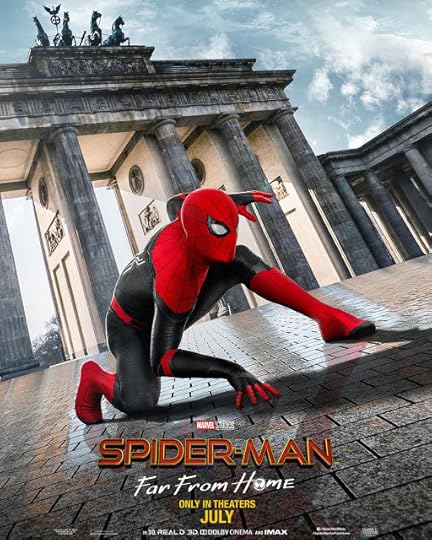
Not as good as “Spider-Man: Homecoming," but not a bad way to pass a couple of hours. Jake Gyllenhaal makes for an entertaining, charismatic villain (technically, that’s a spoiler, but if you’re reading this blog I’m guessing you know who Mysterio is, and even if you don’t, it’s not a tough twist to predict) and Tom Holland, as always, excels as portraying our friendly neighborhood you-know-who. I’m not crazy about taking Peter and the gang out of Manhattan, though I get the appeal of a foreign setting and brand-new buildings that can get knocked down. Still, it all feels a little too chaotic as the plot twists and the locations pile-up, and I found myself fondly remembering the small-scale heroics of the previous movie.
On the plus side, there’s a hallucination sequence toward the end that ranks among the most visually impressive scenes in Marvel movie history (and echos similar scenes in both the Lee/Ditko comics and that '60s TV cartoon), and a post-credit scene that manages to (a) feature a beloved actor in a beloved role and (b) sets up one hell of a cliffhanger. Question is, with Marvel and Sony parting ways and Spidey leaving the Marvel Cinematic Universe, will we ever get to see it?
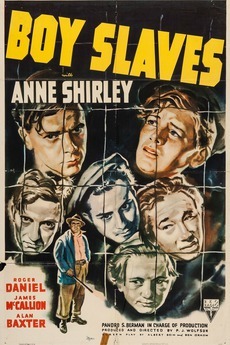
If you haven't seen many movies from the 1930s, you might think it's all sweetness and light and Shirley Temple dancing and Scarlett O'Hara muttering "fiddle dee dee" ... but, of course, that's not the whole story. Even aside from the gangster movies and the melodramas and horror flicks, there were movies that portrayed just how miserable Depression-era life could be, and I'm not just talking about "The Grapes of Wrath." Why, for example, there was a whole '30s genre devoted specifically to showing kids living in hell. There's "Dead End," of course, which introduced the world to the Dead End Kids to the world, and "The Mayor of Hell," with Jimmy Cagney in the lead and some of those same Kids in support. Then there were the kids-on-the-run movies like "Wild Boys on the Road," where children strike out on their own and usually get beat up by cops or have their legs cut off by a train (no kidding). And then, there's "Boy Slaves" ...
Though it was released in 1939, long after the Production Code clamped down, this is one grim movie. Though at first glance it seems to restore social order with its "happy" ending, the feeling that lingers is far from jolly, and the story that precedes it is even worse (aka better): Our hero, young Jesse (Roger Daniel) gets fired from his hellish job for preventing a supervisor from sexually assaulting a girl, then leaves home (after getting slapped by his mom) to find work. He's attacked and robbed by a gang of homeless (and hopeless) kids, then winds up joining then because, well, what else is he going to do? The gang then beats up a rich kid, and they wind up in jail. They're bailed out by a "nice" man who promises them "high wages" at his camp, where the workers strip trees to make turpentine. And that, of course, is where the fun (aka misery) begins.
Naturally, the camp is a living hell, with the boys quickly amassing huge debts in the company story and earning only company scrip to pay it off. They're beaten by the guards, served unhealthy swill and given extremely dangerous jobs. When Jesse escapes (bloodying himself in the process) and tries to bring a letter revealing their treatment to the outside world, he's quickly captured and dragged back to the camp. Eventually, driven to the brink of madness, the boys rebel, starting a riot and hiding in a farmhouse with Annie (top-billed Anne Shirley). The camp owner tries to have his own militia burn down the farmhouse, but actual (and unbelievably reasonable) police show up and take the boys into custody. In the final scene, the wise and gentle judge (also unbelievable) says he's "ashamed to be an American" after seeing how these boys were treated, and promises to send them to a "state farm" where they will "learn a trade." Hmmmm.
Brutal story and uneasy ending aside, "Boy Slaves" manages to feel more desperate and despairing than other films of its ilk. Part of that is thanks to the cast, which, aside from Shirley, is mostly made up of long-forgotten actors, more than a few of them possessing truly strange (and strangely evocative) faces. These kids look like desperate teens, not like extras on the MGM lot. Plus, as David Cairns describes in this insightful post over at The Chisler, director P.J. Wolfson (who never made another movie) directs "Boy Slaves" in a frenetic, almost surreal style, more like a Universal horror movie than a social drama. Poor Jesse's trip through the forest, Cairns points out, has echoes of the previous year's "Snow White."
In case you couldn't tell, this one comes highly recommended.

Not as good as “Spider-Man: Homecoming," but not a bad way to pass a couple of hours. Jake Gyllenhaal makes for an entertaining, charismatic villain (technically, that’s a spoiler, but if you’re reading this blog I’m guessing you know who Mysterio is, and even if you don’t, it’s not a tough twist to predict) and Tom Holland, as always, excels as portraying our friendly neighborhood you-know-who. I’m not crazy about taking Peter and the gang out of Manhattan, though I get the appeal of a foreign setting and brand-new buildings that can get knocked down. Still, it all feels a little too chaotic as the plot twists and the locations pile-up, and I found myself fondly remembering the small-scale heroics of the previous movie.
On the plus side, there’s a hallucination sequence toward the end that ranks among the most visually impressive scenes in Marvel movie history (and echos similar scenes in both the Lee/Ditko comics and that '60s TV cartoon), and a post-credit scene that manages to (a) feature a beloved actor in a beloved role and (b) sets up one hell of a cliffhanger. Question is, with Marvel and Sony parting ways and Spidey leaving the Marvel Cinematic Universe, will we ever get to see it?

If you haven't seen many movies from the 1930s, you might think it's all sweetness and light and Shirley Temple dancing and Scarlett O'Hara muttering "fiddle dee dee" ... but, of course, that's not the whole story. Even aside from the gangster movies and the melodramas and horror flicks, there were movies that portrayed just how miserable Depression-era life could be, and I'm not just talking about "The Grapes of Wrath." Why, for example, there was a whole '30s genre devoted specifically to showing kids living in hell. There's "Dead End," of course, which introduced the world to the Dead End Kids to the world, and "The Mayor of Hell," with Jimmy Cagney in the lead and some of those same Kids in support. Then there were the kids-on-the-run movies like "Wild Boys on the Road," where children strike out on their own and usually get beat up by cops or have their legs cut off by a train (no kidding). And then, there's "Boy Slaves" ...
Though it was released in 1939, long after the Production Code clamped down, this is one grim movie. Though at first glance it seems to restore social order with its "happy" ending, the feeling that lingers is far from jolly, and the story that precedes it is even worse (aka better): Our hero, young Jesse (Roger Daniel) gets fired from his hellish job for preventing a supervisor from sexually assaulting a girl, then leaves home (after getting slapped by his mom) to find work. He's attacked and robbed by a gang of homeless (and hopeless) kids, then winds up joining then because, well, what else is he going to do? The gang then beats up a rich kid, and they wind up in jail. They're bailed out by a "nice" man who promises them "high wages" at his camp, where the workers strip trees to make turpentine. And that, of course, is where the fun (aka misery) begins.
Naturally, the camp is a living hell, with the boys quickly amassing huge debts in the company story and earning only company scrip to pay it off. They're beaten by the guards, served unhealthy swill and given extremely dangerous jobs. When Jesse escapes (bloodying himself in the process) and tries to bring a letter revealing their treatment to the outside world, he's quickly captured and dragged back to the camp. Eventually, driven to the brink of madness, the boys rebel, starting a riot and hiding in a farmhouse with Annie (top-billed Anne Shirley). The camp owner tries to have his own militia burn down the farmhouse, but actual (and unbelievably reasonable) police show up and take the boys into custody. In the final scene, the wise and gentle judge (also unbelievable) says he's "ashamed to be an American" after seeing how these boys were treated, and promises to send them to a "state farm" where they will "learn a trade." Hmmmm.
Brutal story and uneasy ending aside, "Boy Slaves" manages to feel more desperate and despairing than other films of its ilk. Part of that is thanks to the cast, which, aside from Shirley, is mostly made up of long-forgotten actors, more than a few of them possessing truly strange (and strangely evocative) faces. These kids look like desperate teens, not like extras on the MGM lot. Plus, as David Cairns describes in this insightful post over at The Chisler, director P.J. Wolfson (who never made another movie) directs "Boy Slaves" in a frenetic, almost surreal style, more like a Universal horror movie than a social drama. Poor Jesse's trip through the forest, Cairns points out, has echoes of the previous year's "Snow White."
In case you couldn't tell, this one comes highly recommended.
Published on September 12, 2019 08:32
September 11, 2019
Movies I Watched In July: "The Hardys Ride High"
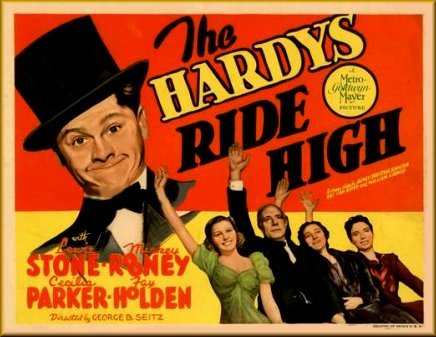
When my wife caught me watching this bit of vintage 1939 nonsense, she just stared at the screen stared at me, and asked “What is it that you see in these movies?” And I had a hard time putting it into words. There’s just something about Mickey Rooney, especially in these “Andy Hardy” movies, when he was the biggest movie star in the whole wide world, that fascinates me on a level that goes beyond (and beneath) whatever is happening onscreen.
What’s onscreen, to be honest, ain’t much – these movies are really closer to long sitcoms than actual films. They were released as fast as MGM could crank them out, they all focused on the same characters – Andy Hardy (Rooney); his dad, Judge Hardy (Lewis Stone), his mom (Fay Holden), his sister (Cecelia Parker) and various girlfriends, maids and goofball pals – and they all told simple, allegedly humorous stories with endings that tied everything up in a neat little bundle and reinforced the MGM-sanctioned status quo. They’re not good, exactly, but they’re slickly made and they reveal how Hollywood idealized small-town America 80 years ago. And, of course, they feature Rooney at his untethered best, young enough to still be relatively sane but old enough to be way too old to play the clean-cut hero. (At the same time he was pretending to be a teenager intimidated by a date in the big city he was, in reality, sleeping his way through Los Angeles.) And some of that dichotomy comes across in silly movies like “The Hardys Ride High” – Rooney acts so crazy and over the top that he barely seems human at times, much less like your typical, all-American teenager.
So what happens in this specific movie? Not much. Judge Hardy gets the news that he could be heir to $2 million dollars, so the whole family goes to Detroit to claim the inheritance. Everyone but the judge goes money mad before coming back to their senses (of course). Andy goes the most money mad (also, of course) but after almost falling prey to some big city con artists, he returns to the roost and the family returns to their mythical hometown of Carvel, wiser if not wealthier. The End.
So, the question remains: Seriously – what the hell do I see in these movies?
Up next: Spider-Man and Slave Boys!
Published on September 11, 2019 17:02
September 9, 2019
Movies I Watched in July, Part 1
p.p1 {margin: 0.0px 0.0px 0.0px 0.0px; font: 12.0px 'Times New Roman'; color: #000000} span.s1 {font-kerning: none} span.Apple-tab-span {white-space:pre}
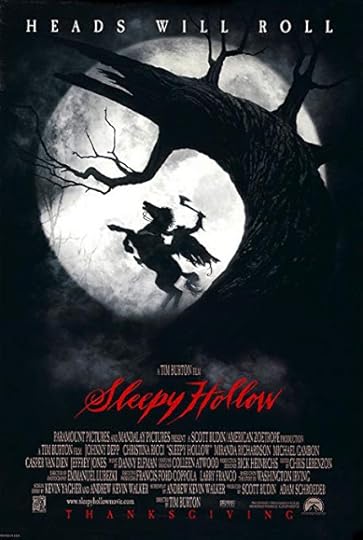
Watched this one as part Allie’s gradual education in horror, and it wound up being quite a bit better than I remembered. "Sleepy Hollow" feels like one of Tim Burton’s last good movies before his decades-long, big-budget decline (paused briefly, if you ask me, for his highly underrated 2014 movie, “Big Eyes”), but it remains a fun film for the Halloween season, with the New England setting depicted beautifully and an actual R rating that gives Burton and company the freedom to show plenty of decapitations and other gruesome deaths. The plot is twisted around to make Ichabod Crane (Johnny Depp, of course) a forward-thinking detective instead of a geeky schoolteacher, but I’ll allow it seeing as how it lets the tale expand beyond its short story (and Disney cartoon) origins. Plus, the cast is not only top-notch, it also acts as a sort of dry run for the “Harry Potter” films (Michael Gambon, Richard Griffiths, Miranda Richardson) and the “Star Wars” prequels (Ian McDiarmid, Christopher Lee) with Christina Ricci, Christopher Walken, Jeffrey Jones and Caspar Van Dien (!) tossed in as a bonus. Well worth a look, especially at this time of year.
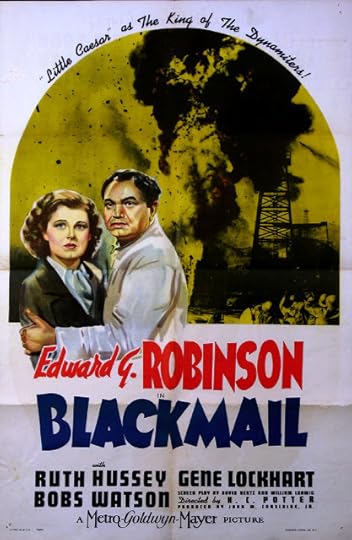
Solid Eddie G. movie that I’d somehow missed seeing for all these years, an omission remedied by (what else?) TCM. Robinson plays a nice guy, good father and loving husband working fighting oil fires, but he’s hiding (what else?) a dark secret: Years earlier, under another name, he escaped from a brutal chain gang where he was imprisoned for (what else?) a crime he didn’t commit. One of his old acquaintances (Gene Lockhart) shows up and entraps him in a screwy blackmail scheme that lands poor Eddie back on that chain gang. It’s a compelling story, and Robinson is great as always, but what I liked most about the movie was the relationship he had with his wife, played by Ruth Hussey, an actress I've always liked. He might have a deep, dark secret, but he’s not hiding it from her, and she actually helps him out at various points, telling him to stay away from the newsreel cameras, for instance. Their scenes together add a surprising (and surprisingly mature) layer to what could be just another melodrama.

Hoo boy. After watching the excellent, soul-crushing, mind-bending “Hereditary” last spring, I couldn’t wait to see what writer/director Ari Aster came up with next, and thankfully I didn’t have to wait long. “Midsommar” sets up a classic “Wicker Man” sort of situation, where Dani (Florence Pugh, excellent in what couldn’t have been an easy role) goes to a Swedish festival with her boyfriend and his buddies after she suffers an unimaginable tragedy. The fact that her boyfriend, “Christian” (ha ha) was all set to dump her adds a layer of tension, but that’s just the tip of the northern iceberg as far as bad vibes go in this movie. The Midsommar festival gets stranger and stranger as the days go by, and the fact that those days seem unending thanks to so many hours of sunlight makes things even creepier for the characters – and the audience. I won’t spoil any of the twists, of which there are a few, except to say that though it reaches some of the same levels of terror as “Hereditary,” it also tosses in some well-played humor that makes the viewing experience slightly less overwhelming. Still, it’s a hell of a movie with a hell of an ending, and I guarantee you’ll see some things onscreen that you’ve never, ever seen before. One of the year's best, by far. Highly recommended.
Up next: Spider-Man goes to Europe, Andy Hardy goes to Detroit and some homeless kids go to a turpentine camp in the grimmest 1930s movies you've never heard of.

Watched this one as part Allie’s gradual education in horror, and it wound up being quite a bit better than I remembered. "Sleepy Hollow" feels like one of Tim Burton’s last good movies before his decades-long, big-budget decline (paused briefly, if you ask me, for his highly underrated 2014 movie, “Big Eyes”), but it remains a fun film for the Halloween season, with the New England setting depicted beautifully and an actual R rating that gives Burton and company the freedom to show plenty of decapitations and other gruesome deaths. The plot is twisted around to make Ichabod Crane (Johnny Depp, of course) a forward-thinking detective instead of a geeky schoolteacher, but I’ll allow it seeing as how it lets the tale expand beyond its short story (and Disney cartoon) origins. Plus, the cast is not only top-notch, it also acts as a sort of dry run for the “Harry Potter” films (Michael Gambon, Richard Griffiths, Miranda Richardson) and the “Star Wars” prequels (Ian McDiarmid, Christopher Lee) with Christina Ricci, Christopher Walken, Jeffrey Jones and Caspar Van Dien (!) tossed in as a bonus. Well worth a look, especially at this time of year.

Solid Eddie G. movie that I’d somehow missed seeing for all these years, an omission remedied by (what else?) TCM. Robinson plays a nice guy, good father and loving husband working fighting oil fires, but he’s hiding (what else?) a dark secret: Years earlier, under another name, he escaped from a brutal chain gang where he was imprisoned for (what else?) a crime he didn’t commit. One of his old acquaintances (Gene Lockhart) shows up and entraps him in a screwy blackmail scheme that lands poor Eddie back on that chain gang. It’s a compelling story, and Robinson is great as always, but what I liked most about the movie was the relationship he had with his wife, played by Ruth Hussey, an actress I've always liked. He might have a deep, dark secret, but he’s not hiding it from her, and she actually helps him out at various points, telling him to stay away from the newsreel cameras, for instance. Their scenes together add a surprising (and surprisingly mature) layer to what could be just another melodrama.

Hoo boy. After watching the excellent, soul-crushing, mind-bending “Hereditary” last spring, I couldn’t wait to see what writer/director Ari Aster came up with next, and thankfully I didn’t have to wait long. “Midsommar” sets up a classic “Wicker Man” sort of situation, where Dani (Florence Pugh, excellent in what couldn’t have been an easy role) goes to a Swedish festival with her boyfriend and his buddies after she suffers an unimaginable tragedy. The fact that her boyfriend, “Christian” (ha ha) was all set to dump her adds a layer of tension, but that’s just the tip of the northern iceberg as far as bad vibes go in this movie. The Midsommar festival gets stranger and stranger as the days go by, and the fact that those days seem unending thanks to so many hours of sunlight makes things even creepier for the characters – and the audience. I won’t spoil any of the twists, of which there are a few, except to say that though it reaches some of the same levels of terror as “Hereditary,” it also tosses in some well-played humor that makes the viewing experience slightly less overwhelming. Still, it’s a hell of a movie with a hell of an ending, and I guarantee you’ll see some things onscreen that you’ve never, ever seen before. One of the year's best, by far. Highly recommended.
Up next: Spider-Man goes to Europe, Andy Hardy goes to Detroit and some homeless kids go to a turpentine camp in the grimmest 1930s movies you've never heard of.
Published on September 09, 2019 16:43
September 5, 2019
Blog Movie Recap, Special Stonewall Edition: Some of My Best Friends Are....
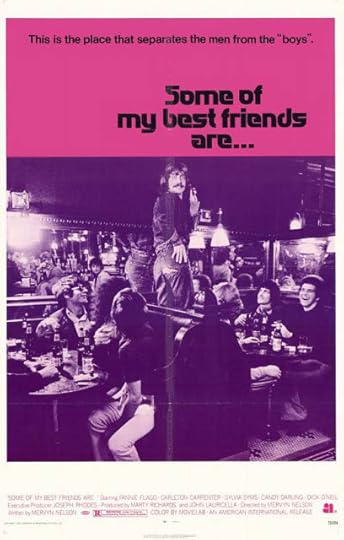
Here's one of the most obscure movies I've ever seen, broadcast on (what else?) Turner Classic Movies as part of its commemoration of the 50th anniversary of the Stonewall uprising. Aside from a brief write-up in "The Celluloid Closet," this 1971 movie seems to have dropped off the face of the earth. It's never, as far as I can tell, been released on home video, and it's not even included on the extremely comprehensive Every 70s Movie site.
Taking place on a single night (Christmas Eve) and in a single location (The Blue Jay, a gay bar in Greenwich Village), "Some of My Best Friends Are ..." (written and directed by Mervyn Nelson) is a fascinating relic of an earlier age. Released in an era when gay characters were just starting to be included in Hollywood films without being elaborately concealed or "coded," it's startlingly dated in how it depicts those characters. It's also startling in how it takes place in a world almost no other movie was willing to explore back in 1971.
The Blue Jay is full of gay men who embody the stereotypes of the era -- they're either desperately unhappy, lovelorn (and unhappy), closeted (and unhappy) or wildly flamboyant (and unhappy). All that unhappiness is cranked up to near-oppressive levels by the end of the movie, but there's enough variety in the storylines to keep things interesting: Jim is a hustler pretending to be the "nephew" of an older, richer guy. Graphic artist Terry and pilot Scott are happy (for the moment), but Lita brought Scott to the bar originally and now wants to destroy their happiness. Ski instructor Michel is trying to convince his closeted lover Barratt to leave his wife. And, in the most dramatic (and brutal) plotline, macho Jim tries to re-establish his straight bonafides by dancing with Karen, a lonely woman at the end of the bar -- only to discover that Karen is actually not a woman after all. Then there's the cop shaking down The Blue Jay for lucrative pay-offs (something quite common in real-life gay bars), the waiter seeking true love and Helen, the woman who helps run the bar and acts as a substitute mother for its customers (especially Terry, whose actual mother shows up -- invited by Lita -- and is less than thrilled to discover her son's big secret).
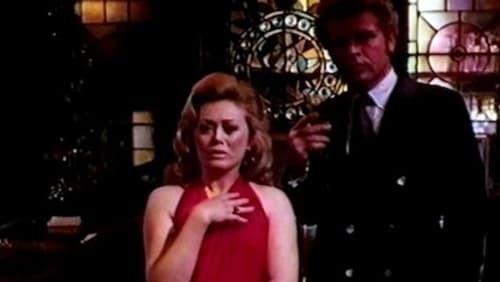
At its heart, "Some of My Best Friends Are..." is little more than a semi-tragic melodrama, but because it's a melodrama focused on characters who remained hidden in the background of other movies, and because the emotions involved are so nakedly on display, I found the damned thing mesmerizing. It's not especially well-made, and it's definitely not slick or impressive-looking, but in my life, I've watched hundreds of low budget movies fueled by subject matter bigger movies wouldn't touch, and this fits right in with those. Plus, the cast includes some surprising names: Gil Gerard (yes, Buck Rogers) plays Scott, Gary Sandy (Andy from "WKRP") plays Jim, Fannie Flagg (of a million '70s gam shows) plays Helen, Rue McClanahan (of "The Golden Girls") plays Rita and Warhol regular Candy Darling plays Karen. All of them are surprisingly good, especially Gerard, playing a regular, down-to-Earth character with many more shades than Buck.
I've praised Turner Classic Movies many times in this blog, and this showing of a movie like "Some of My Best Friends Are..." is a perfect example of why it's so prized by fans of film history. Who else is going to go to the trouble of unearthing an artifact from the dawn of gay rights and put it on the air?
By the way, if you're interesting in watching this slow, melodramatic -- but fascinating -- time capsule, you can do so right now, for free, on Amazon Prime.
Published on September 05, 2019 16:47
September 4, 2019
The Movie Recap Continues: Toy Story 4
Continuing the June (yes, June) recap...
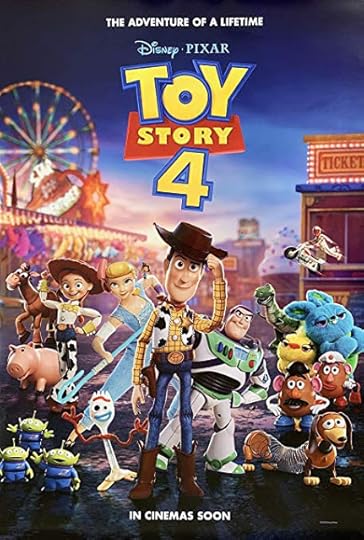
It doesn't reach the same glorious heights as "Toy Story 3" (few movies do), but it demonstrates once again what sets Pixar's movies apart from all the other trolls and angry birds and pets with their secret lives. Instead of making the same "Toy Story" again, which would probably still satisfy the critics and would definitely still satisfy the audiences, director Josh Cooley and the (extensive) team of writers tell a story that could only be told given the adventures Woody, Buzz and the rest have already shared. They're older, wiser and more relaxed, less focused on solving their own problems than they are on helping others, including brand-new homemade toy Forky (Tony Hale) and old friend Bo Peep (Annie Potts, who it's great to have back).
"Toy Story" is a damn good movie, delivering that patented Pixar mix of comedy, adventure and heart (including an ending that I found genuinely surprising -- and touching), but what's really striking is how gorgeous it looks. Scenes at a carnival have a sense of fun and grandeur, but it's the sequences set in an antique store that are truly breathtaking, full of stunning lights and colors. It's no wonder that, every so often, the movie slows down and lets us drink it all in. Maybe that's the key to Pixar's success, at least when it comes to the "Toy Story" films: The creators deliver consistently strong stories (which is no simple trick -- just look at most movie sequels) while upping the technology each time around, meaning that what was revolutionary 25 years ago looks primitive by comparison in 2019 -- but that matters less than you might think.
The original "Toy Story" had such a strong story and interesting characters that while its looks have aged, its appeal remains as strong as ever. I saw it in the theater and was blown away by the visuals, but even though the humans look, frankly, crude these days, the story and characters stand the test of time. It's hard to imagine anyone improving dramatically on the images in "Toy Story 4," but even if they do, its story -- which makes room for carnival toys voiced by Key and Peele, an Evel Knievel knockoff voiced by Keanu Reeves and some very unnerving ventriloquist dummies -- will be just as much fun as it was this summer.

It doesn't reach the same glorious heights as "Toy Story 3" (few movies do), but it demonstrates once again what sets Pixar's movies apart from all the other trolls and angry birds and pets with their secret lives. Instead of making the same "Toy Story" again, which would probably still satisfy the critics and would definitely still satisfy the audiences, director Josh Cooley and the (extensive) team of writers tell a story that could only be told given the adventures Woody, Buzz and the rest have already shared. They're older, wiser and more relaxed, less focused on solving their own problems than they are on helping others, including brand-new homemade toy Forky (Tony Hale) and old friend Bo Peep (Annie Potts, who it's great to have back).
"Toy Story" is a damn good movie, delivering that patented Pixar mix of comedy, adventure and heart (including an ending that I found genuinely surprising -- and touching), but what's really striking is how gorgeous it looks. Scenes at a carnival have a sense of fun and grandeur, but it's the sequences set in an antique store that are truly breathtaking, full of stunning lights and colors. It's no wonder that, every so often, the movie slows down and lets us drink it all in. Maybe that's the key to Pixar's success, at least when it comes to the "Toy Story" films: The creators deliver consistently strong stories (which is no simple trick -- just look at most movie sequels) while upping the technology each time around, meaning that what was revolutionary 25 years ago looks primitive by comparison in 2019 -- but that matters less than you might think.
The original "Toy Story" had such a strong story and interesting characters that while its looks have aged, its appeal remains as strong as ever. I saw it in the theater and was blown away by the visuals, but even though the humans look, frankly, crude these days, the story and characters stand the test of time. It's hard to imagine anyone improving dramatically on the images in "Toy Story 4," but even if they do, its story -- which makes room for carnival toys voiced by Key and Peele, an Evel Knievel knockoff voiced by Keanu Reeves and some very unnerving ventriloquist dummies -- will be just as much fun as it was this summer.
Published on September 04, 2019 18:16
September 3, 2019
Movies I've Watched, well, Semi-Recently
It's been awhile since I've posted here at X-Ray Spex. In fact, I think that Aug. 2019 might be the very first month I've skipped completely on the blog since I first launched it, way back in 2004. In this age of Twitter and Facebook and Instagram and whatever other social media I'm too old to keep track of, it feels like a blog is an artifact of the Internet's distant past, a complicated relic from the days when people actually wrote (and, hopefully, read).
But I've got no plans to give up this old ship. It's an excuse for me to sit down and actually put my thoughts into words, and it's a way to continue doing what I did for more than a decade during my career at the newspaper ... namely write about movies (among other things). I don't get free DVDs and Blu-rays like I once did, in those long-ago days when a newspaper film critic (even part time) was a viable economic option. But, with this blog, I can write about whatever I want. So that's nice, right? I just have to plant myself in front of the keyboard and do it.
So here I am, and here are some very quick recaps of what I watched way back in (gulp) June. Some of them deserve more attention than I'm giving them here, but for now, I just want to get back on the horse -- and get some content up on this barren old blog.
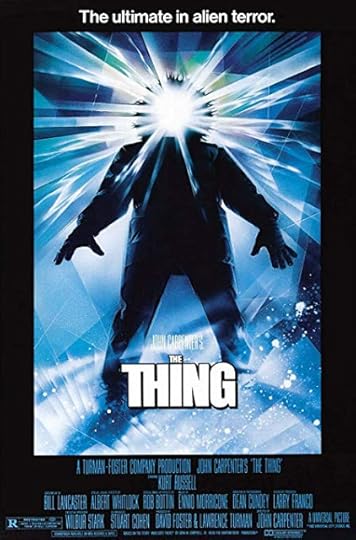
An all-time classic, of course, and a movie I'd rate higher than John Carpenter's other legendary horror movie, "Halloween." This time around, we showed it to Allie, and, no surprise, it scared the pants off her. Want to read more? Check out the recap from my month-long Horror Movie Marathon from October 2007.
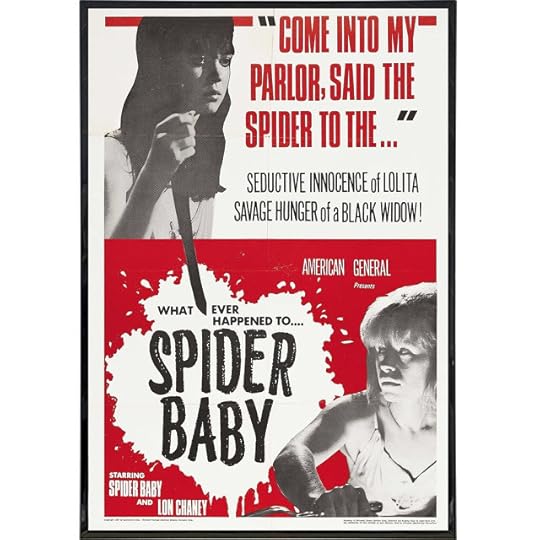
Creepy as hell but also a lot of fun, sort of like an episode of "The Addams Family" gone very, very wrong. Lon Chaney Jr., on his last legs but gamely hanging on, plays the chauffeur looking after three twisted siblings (Jill Banner, Beverly Washburn and, yes, Sid Haig) suffering from "Merrye Syndrome," which causes them to regress in age -- and into madness. When greedy relatives show up looking for the inheritance ... well, I'm sure you can guess what happens. Funny, disturbing and definitely one of a kind, "Spider Baby" earns big bonus points for (a) having Chaney sing the bouncy theme song and (b) casting screen legend Mantan Moreland as the film's first victim.
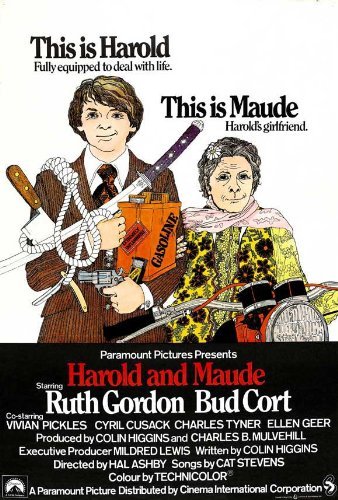
One of my all-time favorite movies and, I'd argue, one of the all-time great screen romances, with death obsessed Harold (Bud Cort) falling in love not just with octogenarian Maude (Ruth Gordon) but with life itself. (And yes, I realize how unbearably corny that sentence sounds, but trust me on this.) Another one we showed to Allie, and when she commented that one of Harold's set-up dates seemed a little old for him, we laughed and laughed at the love connection she didn't see coming.
Up next: Pixar's latest and one of the most fascinating movies I've seen in a long time -- and had never even heard of until I watched it.
p.p1 {margin: 0.0px 0.0px 0.0px 0.0px; font: 12.0px 'Times New Roman'; color: #000000} span.s1 {font-kerning: none} span.Apple-tab-span {white-space:pre}
But I've got no plans to give up this old ship. It's an excuse for me to sit down and actually put my thoughts into words, and it's a way to continue doing what I did for more than a decade during my career at the newspaper ... namely write about movies (among other things). I don't get free DVDs and Blu-rays like I once did, in those long-ago days when a newspaper film critic (even part time) was a viable economic option. But, with this blog, I can write about whatever I want. So that's nice, right? I just have to plant myself in front of the keyboard and do it.
So here I am, and here are some very quick recaps of what I watched way back in (gulp) June. Some of them deserve more attention than I'm giving them here, but for now, I just want to get back on the horse -- and get some content up on this barren old blog.

An all-time classic, of course, and a movie I'd rate higher than John Carpenter's other legendary horror movie, "Halloween." This time around, we showed it to Allie, and, no surprise, it scared the pants off her. Want to read more? Check out the recap from my month-long Horror Movie Marathon from October 2007.

Creepy as hell but also a lot of fun, sort of like an episode of "The Addams Family" gone very, very wrong. Lon Chaney Jr., on his last legs but gamely hanging on, plays the chauffeur looking after three twisted siblings (Jill Banner, Beverly Washburn and, yes, Sid Haig) suffering from "Merrye Syndrome," which causes them to regress in age -- and into madness. When greedy relatives show up looking for the inheritance ... well, I'm sure you can guess what happens. Funny, disturbing and definitely one of a kind, "Spider Baby" earns big bonus points for (a) having Chaney sing the bouncy theme song and (b) casting screen legend Mantan Moreland as the film's first victim.

One of my all-time favorite movies and, I'd argue, one of the all-time great screen romances, with death obsessed Harold (Bud Cort) falling in love not just with octogenarian Maude (Ruth Gordon) but with life itself. (And yes, I realize how unbearably corny that sentence sounds, but trust me on this.) Another one we showed to Allie, and when she commented that one of Harold's set-up dates seemed a little old for him, we laughed and laughed at the love connection she didn't see coming.
Up next: Pixar's latest and one of the most fascinating movies I've seen in a long time -- and had never even heard of until I watched it.
p.p1 {margin: 0.0px 0.0px 0.0px 0.0px; font: 12.0px 'Times New Roman'; color: #000000} span.s1 {font-kerning: none} span.Apple-tab-span {white-space:pre}
Published on September 03, 2019 17:55
July 31, 2019
Movies I Watched in June, Part 2
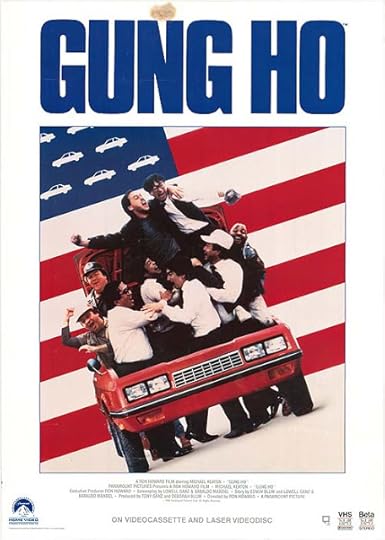
There are a lot of ‘80s movies that look extremely EIGHTIES in retrospect – “Less Than Zero,” “Wall St.,” “The Lost Boys,” “Flashdance” – but one that frequently gets left off that list is this little gem from 1986. It’s not as flashy as, say, “The Lost Boys” (is anything?), but it sums up the decade in a less colorful, possibly less subtle, definitely more racist way. Michael Keaton, at the height of his first wave of star power, plays the Michael Keaton-type guy trying to bring a Japanese automaker to a dying Pennsylvania town. The Japanese are tight-assed workaholics, the Americans are half-drunk goofballs, and it’s hard to really root for either side (though in 1986 you’d better believe you were supposed to be on the side of the good ol’ red, white and blue!) Plot, clichés and feel good ending aside, it’s a strange movie, one of those films that’s not funny enough to be considered a comedy and not involving enough to be a drama. Keaton is great, of course, but you wish the screenplay (by Lowell Ganz and Babaloo Mandel) had given him something interesting to do, and that director Ron Howard had figured out an original way to show it, other than stage half the film in music video-style montages. The cast is interesting (though largely wasted) with guys like George Wendt (obvious) and John Turturro (what?) playing the autoworkers and Gedde Watanabe (a year after playing, ahem, Long Duk Dong in “Sixteen Candles”) as Keaton’s Japanese equivalent. They’re all fine in their roles, but the movie isn’t really about anything, least of all the changing auto industry. Everyone fights, then shakes hands and digs in and wins some arbitrary challenge and it’s happy endings for all, except, of course, the one mean guy you were rooting against the whole time. I saw this in 1986 in the theater, and then I watched it in June. Maybe I’ll watch it again in another 33 years.
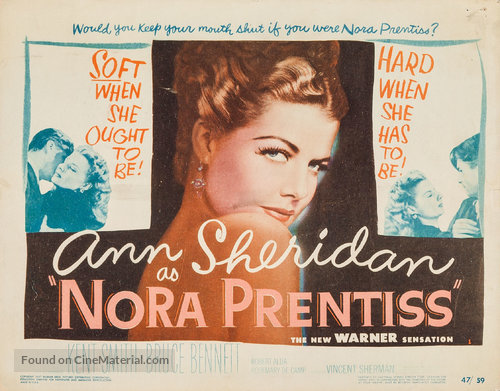
Solid little film noir that I’d never seen before, presented (of course) by the great Eddie Muller on (what else?) TCM’s “Noir Alley.” It was aimed at making a big star of Ann Sheridan (giving her a title role ala Joan Crawford’s in “Mildred Pierce,” but oddly enough, the main character isn’t Nora. Instead, it’s a mild-mannered, straight-laced buttoned-up doctor played by Kent Smith (who co-stars in two of my favorite movies, “Cat People” and “The Fountainhead.”) Smith’s character, Richard Talbot, falls head over heels for Nora after treating her for a minor injury, then tears his entire (previously swell) life to pieces trying to make their relationship a reality. Among the things that set this movie apart: One, Nora and her various shady friends don’t try to swindle Talbot or otherwise do him harm, as is usually the case in noir. (See, for instance, “The Woman in the Window” or “Scarlett Street,” where Joan Bennett and Dan Duryea wreck Edward G. Robinson’s life.) Instead, it’s all Talbot’s own stupid fault. Two, Talbot comes up with the craziest scheme I’ve ever seen to escape the law, then (of course) it all backfires on him. And three, the cinematography is by the great James Wong Howe, meaning no matter how dumb the main character is or how goofy the plot gets, it all looks spectacular.
Up next: A horror classic, a horror cult classic and a classic cult classic.
Published on July 31, 2019 03:38
July 23, 2019
Movies I Watched in June, Part 1
Here goes -- Part One of what turned out to be a pretty movie-packed month...
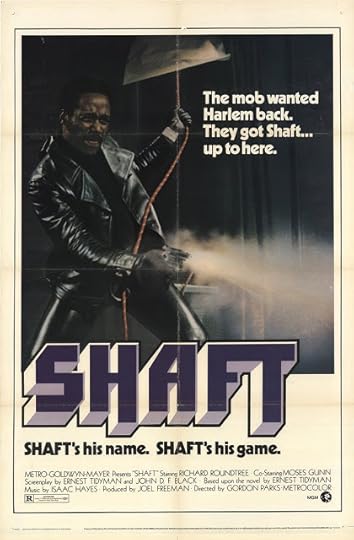
I realize this 1971 movie is considered a blaxploitation classic (possibly THE blaxploitation classic), but to be honest, I didn't find myself loving it. If you ask me (and by reading this blog, you sort of tacitly are asking me), it’s too straightforward and too straitlaced, failing to hit the wild heights of less respectable fare like “Truck Turner” and “Sweet Sweetback’s Baadasssss Song,” to say nothing of genuinely disreputable films like “Super Soul Brother,” “Welcome Home, Brother Charles” or the oeuvre of one mister Rudy Ray Moore. “Shaft” isn’t bad by any means, but it feels like your average ‘70s cop drama with a quick coat of blaxploitation slapped on it. Richard Roundtree is iconic as John Shaft, of course, and Moses Gunn is great as the head of the black mob, but the whole movie just never quite came together for this viewer. By all means, check out the Isaac Hayes soundtrack, then skip ahead to “Shaft’s Big Score,” the 1972 sequel that I find much more entertaining. Check out my blog post on that film here .
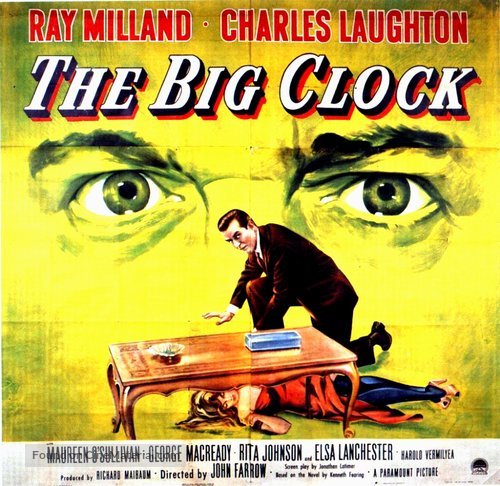
One of my all-time favorite movies just got a swanky new Blu-ray from the fine folks at Arrow Films, which means I had to (a) buy it and (b) give it a rewatch. Ray Milland stars as George Stroud, editor of a true crime magazine that’s part of the publishing empire run by the power-crazed Earl Janoth (a wonderfully feverish Charles Laughton.) When Janoth kills his mistress, he orders Stroud to track down the guy seen leaving her apartment, intending to pin the crime on him. What Janoth doesn’t know is that Stroud was that man, meaning he’s leading a manhunt for himself. (Yes, it’s the same basic story as the Kevin Costner movie “No Way Out.") What follows is a wildly entertaining cat-and-mouse game, with Stroud trying to figure a way out of the ever-tightening net while dealing with a crazy artist (Elsa Lanchester), his own frustrated wife (Maureen O’Sullivan), Janoth’s weaselly assistant (George Macready, who made a career of playing weasels) and, most surprisingly, Janoth’s mute brute of a thug (played by Col. Potter himself, Harry Morgan). It’s fast-paced, it’s smart and the setting of the Janoth Building, which combines midcentury modern design with leading-edge technology (for 1948, that is) is consistenly fascinating. Highest possible recommendation, kiddos.
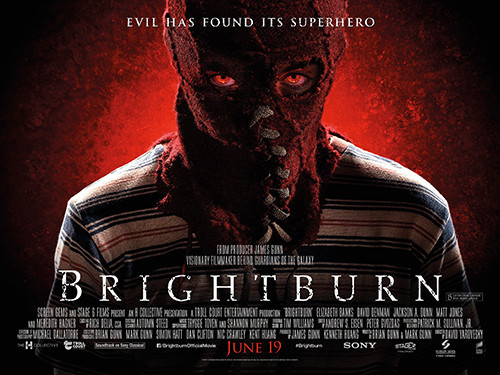
Sure, it’s not any more complex than “What If Superman Were Evil?,” but within that seemingly limited range, this movie (written by Brian and Mark Gunn, directed by David Yarovesky) generates some darkly comic creepiness. I like how little Brandon Breyer (played by Jackson A. Dunn) slips bit by bit, taking revenge on the kids and parents who’ve wronged him and even crafting a snazzy little costume and logo (based on his BB initials). I also like how his parents, played by Elizabeth Banks and David Denman (Roy from “The Office”) have no idea how to handle their changing son. (Would you? Would anyone?) Most of all, I like how the movie goes in a certain direction, then keeps going, much further than I would’ve predicted. I won’t spoil the ending, but it’s a good one, in all the best bad ways.
Up next: a very '80s look at some very '80s economic issues, a bizarre noir I'd never heard of and a terrifying, gory, nasty shocker that I chose to unleash on my poor, innocent daughter.

I realize this 1971 movie is considered a blaxploitation classic (possibly THE blaxploitation classic), but to be honest, I didn't find myself loving it. If you ask me (and by reading this blog, you sort of tacitly are asking me), it’s too straightforward and too straitlaced, failing to hit the wild heights of less respectable fare like “Truck Turner” and “Sweet Sweetback’s Baadasssss Song,” to say nothing of genuinely disreputable films like “Super Soul Brother,” “Welcome Home, Brother Charles” or the oeuvre of one mister Rudy Ray Moore. “Shaft” isn’t bad by any means, but it feels like your average ‘70s cop drama with a quick coat of blaxploitation slapped on it. Richard Roundtree is iconic as John Shaft, of course, and Moses Gunn is great as the head of the black mob, but the whole movie just never quite came together for this viewer. By all means, check out the Isaac Hayes soundtrack, then skip ahead to “Shaft’s Big Score,” the 1972 sequel that I find much more entertaining. Check out my blog post on that film here .

One of my all-time favorite movies just got a swanky new Blu-ray from the fine folks at Arrow Films, which means I had to (a) buy it and (b) give it a rewatch. Ray Milland stars as George Stroud, editor of a true crime magazine that’s part of the publishing empire run by the power-crazed Earl Janoth (a wonderfully feverish Charles Laughton.) When Janoth kills his mistress, he orders Stroud to track down the guy seen leaving her apartment, intending to pin the crime on him. What Janoth doesn’t know is that Stroud was that man, meaning he’s leading a manhunt for himself. (Yes, it’s the same basic story as the Kevin Costner movie “No Way Out.") What follows is a wildly entertaining cat-and-mouse game, with Stroud trying to figure a way out of the ever-tightening net while dealing with a crazy artist (Elsa Lanchester), his own frustrated wife (Maureen O’Sullivan), Janoth’s weaselly assistant (George Macready, who made a career of playing weasels) and, most surprisingly, Janoth’s mute brute of a thug (played by Col. Potter himself, Harry Morgan). It’s fast-paced, it’s smart and the setting of the Janoth Building, which combines midcentury modern design with leading-edge technology (for 1948, that is) is consistenly fascinating. Highest possible recommendation, kiddos.

Sure, it’s not any more complex than “What If Superman Were Evil?,” but within that seemingly limited range, this movie (written by Brian and Mark Gunn, directed by David Yarovesky) generates some darkly comic creepiness. I like how little Brandon Breyer (played by Jackson A. Dunn) slips bit by bit, taking revenge on the kids and parents who’ve wronged him and even crafting a snazzy little costume and logo (based on his BB initials). I also like how his parents, played by Elizabeth Banks and David Denman (Roy from “The Office”) have no idea how to handle their changing son. (Would you? Would anyone?) Most of all, I like how the movie goes in a certain direction, then keeps going, much further than I would’ve predicted. I won’t spoil the ending, but it’s a good one, in all the best bad ways.
Up next: a very '80s look at some very '80s economic issues, a bizarre noir I'd never heard of and a terrifying, gory, nasty shocker that I chose to unleash on my poor, innocent daughter.
Published on July 23, 2019 13:04
Will Pfeifer's Blog
- Will Pfeifer's profile
- 23 followers
Will Pfeifer isn't a Goodreads Author
(yet),
but they
do have a blog,
so here are some recent posts imported from
their feed.



